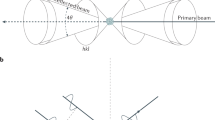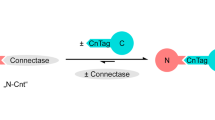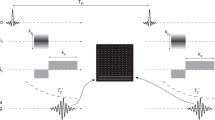Abstract
THERE is a need for a simple method of detecting reactive sulphydryl groups in proteins and polypeptides after separation by zone electrophoresis. Most of the methods for detection and measurement of reactive sulphydryl groups are ultimately based on spectrophotometric measurements and only suitable for the sulphydryl groups of proteins in solution. An alternative method for the detection and comparison of the relative sulphydryl content of electrophoretically separable components of a mixture of polypeptides and/or proteins has been devised. This method which eliminates the need for previous isolation and purification of the protein mixture is based on autoradiography of mercury-203 bound to sulphydryl groups. We report here its application to several proteins with a known sulphydryl content and its use to show the absence of these groups in all tadpole haemoglobin chains and their presence in both chains of several frog haemoglobins.
This is a preview of subscription content, access via your institution
Access options
Subscribe to this journal
Receive 51 print issues and online access
$199.00 per year
only $3.90 per issue
Buy this article
- Purchase on Springer Link
- Instant access to full article PDF
Prices may be subject to local taxes which are calculated during checkout
Similar content being viewed by others
References
Boyer, P. D., in The Enzymes, second ed. (edit. by Boyer, P., Lardy, H., and Myrback, K.), 1, 511 (Academic Press, New York, 1959).
Benesch, R., and Benesch, R. E., in Methods of Biochemical Analysis (edit. by Glick, D.), 10, 43 (Interscience, New York, 1962).
Smith, E. L., and Margoliash, E., Fed. Proc., 23, 1243 (1964).
Trader, C. D., and Frieden, E., J. Biol. Chem., 241, 357 (1966).
Trader, C. D., dissertation, Florida State Univ. (1965).
Frieden, E., in Rec. Prog. Hormone Res., 23, 139 (Academic Press, New York, 1967).
Baglioni, C., and Sparks, C. E., Dev. Biol., 8, 272 (1963).
DeWitt, W., and Ingram, V. M., Biochem. Biophys. Res. Comm., 27, 236 (1967).
Herner, A. E., and Riggs, A., Nature, 198, 35 (1963).
Elzinga, M. G., thesis, Univ. Illinois, University Microfilms, Ann Arbor, Michigan, No. 65–809 (1964).
Stratton, L. P., and Wise, R. W., Fed. Proc., 26, 808 (1967).
Hamada, K., and Shukuya, R., J. Biochem., Japan, 59, 397 (1966).
Jovin, T., Chrambach, A., and Naughton, M. A., Anal. Biochem., 9, 351 (1964).
Braunitzer, G., J. Cell. Biol., 67, Suppl. 1, 1 (1966).
Kasper, C. B., and Deutsch, H. F., J. Biol. Chem., 238, 2325 (1963).
Author information
Authors and Affiliations
Rights and permissions
About this article
Cite this article
STRATTON, L., FRIEDEN, E. Autoradiographic Detection of Reactive Protein-SH and its application to Anuran Haemoglobin Chains. Nature 216, 932–934 (1967). https://doi.org/10.1038/216932a0
Received:
Issue Date:
DOI: https://doi.org/10.1038/216932a0
Comments
By submitting a comment you agree to abide by our Terms and Community Guidelines. If you find something abusive or that does not comply with our terms or guidelines please flag it as inappropriate.



